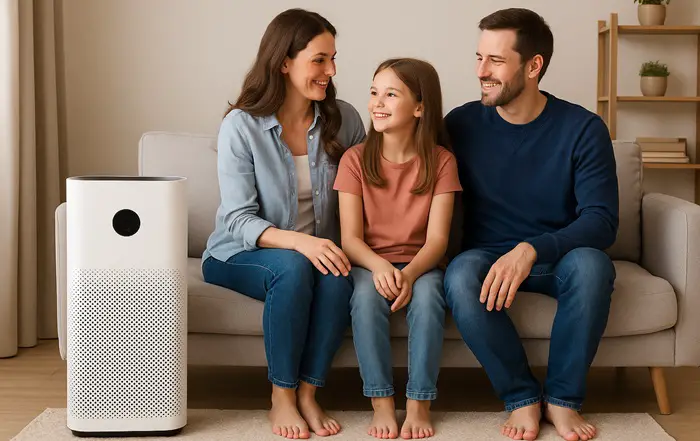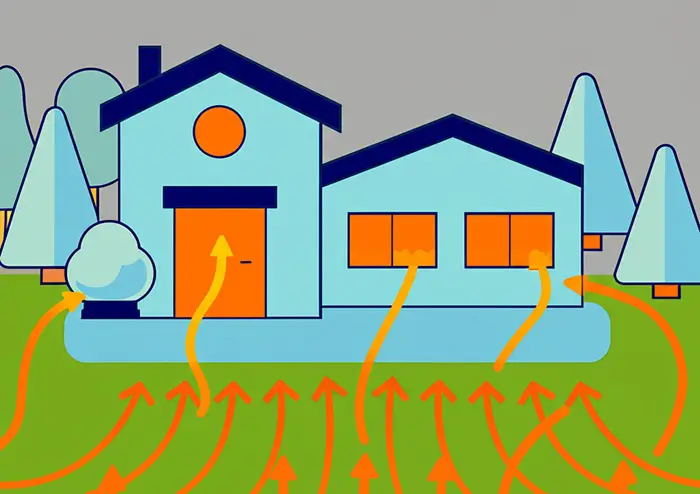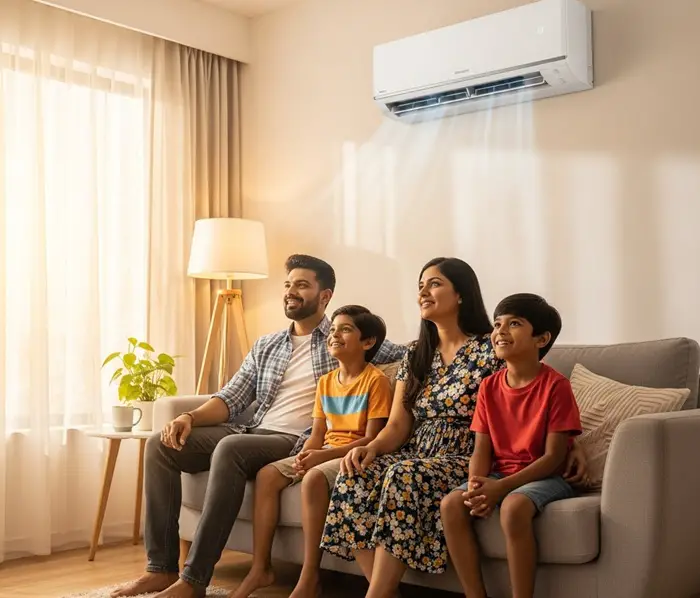
As a homeowner, you take pride in creating a safe, healthy environment for your family — clean air, secure structure, peace of mind.
Naturally, when you hear about radon (an invisible, odorless radioactive gas linked to lung cancer), your first thought is: “Can I just filter it out with an air purifier?”
It’s a smart question — and one we hear often. But the honest answer is:
Standard air purifiers are not effective at reducing radon gas levels.
Here’s why — and what you can do to protect your home.
Air Purifier for Radon – Will It Help?
Radon isn’t your average airborne nuisance. It’s not dust, pollen, or smoke. It’s a noble gas — chemically inert and extremely fine, meaning it glides through most air filters like they’re not even there.
Even high-end purifiers equipped with HEPA filters, designed to trap 99.97% of particles down to 0.3 microns, won’t capture radon gas. HEPA handles particles; radon is a gas, and it simply isn’t caught by particulate filters.
Some purifiers include activated carbon filters, which are better suited for certain gases and odors. These can slightly reduce radon’s radioactive decay products (called “radon progeny”), but they don’t remove the radon gas itself — the real health risk.
If you want to truly eliminate radon risk in your home, there’s only one proven solution—a professionally installed radon mitigation system.
Yes, sealing cracks and improving ventilation can help, but on their own, they’re just temporary band-aids. Radon is a silent, invisible threat that seeps in from beneath your home, and only a mitigation system is designed to stop it at the source.
By actively pulling radon from the ground and safely venting it outside, this system offers the most effective, long-term protection for what matters most: your family’s health.

Buying the Air Purifier for Reducing Radon Gas
When dealing with radon, it’s crucial to understand that mitigation systems (e.g., sub-slab depressurization) should be your first line of defense.
Air purifiers are best used as a complement to these systems, helping reduce your exposure to radon progeny (the dangerous by-products of radon).
Here are the key factors to consider when buying the best air purifier for radon gas:
1- HEPA Filtration: Look for a purifier with a True HEPA filter because it captures 99.97% of airborne particles ≥ 0.3 microns. This is crucial, as radon decay products often attach to dust, which HEPA filters can effectively remove.
2- Activated Carbon Filter: While not primarily designed for gases, activated carbon filters can adsorb small amounts of radon gas and eliminate volatile organic compounds (VOCs) often found in indoor environments with radon issues.
3- Air Changes Per Hour (ACH): Choose a purifier with at least 4–5 ACH for the size of your room. A higher ACH means the air is filtered more frequently, which is essential for reducing the concentration of radon progeny in the air.
4- CADR Rating (Clean Air Delivery Rate): Though CADR doesn’t measure radon directly, a high CADR for dust and smoke indicates the unit’s ability to remove fine particles, including those carrying radon decay products.
5- Room Coverage: Always match the purifier to your room size. For best results, pick a unit that covers slightly more square footage than your room to ensure strong performance.
6- Noise Level, Filter Replacement Cost & Frequency: If you plan to use the purifier in a bedroom or quiet space, look for models that run at <50 dB on low settings to ensure minimal noise disruption.
Also, check how often filters need to be replaced and their cost. Some purifiers require frequent filter changes, which can add to long-term costs, so maintenance and availability matter.
7- Smart Features: Optional features like air quality sensors, auto mode, Wi-Fi connectivity, and filter replacement indicators can make the purifier more efficient and user-friendly. While these are not mandatory, make sure the purifier is:
- Energy Star certified for energy efficiency,
- AHAM Verified for CADR ratings,
- CARB-compliant (safe ozone emission), and
- Comes from a reputable brand with solid warranty support.
Avoid ozone generators and ionizers—these do not remove radon and may actually introduce harmful ozone into your indoor air. Also, steer clear of cheap, uncertified purifiers with vague specs.

How Does Radon Enter a Home and How Can I Test It?
You can’t see, smell, or taste radon, but this invisible gas could be silently putting your family’s health at risk.
Radon enters homes through tiny cracks in the foundation, gaps around pipes, and other small openings. Once inside, it can build up to dangerous levels without any obvious warning signs.
The good news? Testing for radon is easy, affordable, and could make a big difference. You can hire a qualified professional or simply use a do-it-yourself kit—it only takes a small effort for peace of mind.
Step 1: Choose a Reliable Test Kit
Purchase an EPA-approved radon test kit from a hardware store, online retailer, or your state’s radon program. There are two main types:
- Short-term tests (2–7 days): Great for a quick snapshot.
- Long-term tests (90 days to 1 year): More accurate for year-round exposure.
Step 2: Place the Kit Properly
- Choose the lowest livable level of your home (like a basement or ground floor).
- Place it in a dry, well-used room—avoid kitchens, bathrooms, and drafty areas.
- Keep it at least 20 inches off the floor, away from windows, doors, and vents.
- Follow the kit instructions carefully.
Step 3: Leave It Undisturbed
Let the test sit for the recommended time without moving it. Keep doors and windows closed as much as possible during the test.
Step 4: Seal and Send for Results
After the testing period, seal the kit as instructed and mail it to the lab provided. Results usually come within a few days to a couple of weeks.
Step 5: Take Action If Needed
If your radon level is 4.0 picocuries per liter (pCi/L) or higher, don’t wait. The EPA recommends mitigation to vent the gas safely out of your home. Sealing entry points and improving airflow can also significantly reduce radon levels.
Even slightly lower levels may warrant action, especially with long-term exposure.

Does Air Conditioning Reduce Radon? (Role of HVAC Systems in Radon Mitigation)
Many homeowners assume that running the air conditioner keeps indoor air clean and safe—but when it comes to radon, your HVAC system isn’t the solution—it’s only part of the picture.
Radon is a radioactive gas that enters from the ground below, not from indoor air circulation. While air conditioning may cool your home and filter out dust or allergens, it does not remove radon gas from the air.
In fact, depending on how your HVAC system is set up, it could even contribute to pressure differences that draw more radon into the home.
That said, HVAC systems can play a supporting role in reducing radon—if used strategically:
- Balanced ventilation systems, like HRVs (heat recovery ventilators), can help lower radon by bringing in fresh outdoor air while venting stale, radon-laden air out.
- Properly sealed ductwork and pressure balancing can reduce the vacuum effect that pulls radon from the soil into your living space.
But make no mistake: no HVAC system alone can protect your family from radon.
If your home tests high, a professionally installed radon mitigation system is the only proven solution. It directly removes radon at the source—beneath your foundation—and vents it safely outside before it can ever reach your lungs.
The conclusion
Radon is more than just a hidden gas—it’s a serious health threat. As a radioactive substance, it can damage lung tissue when inhaled, even at low levels over time. What makes it especially alarming is that radon exposure is the second leading cause of lung cancer in the United States, claiming thousands of lives each year, many of them non-smokers.
Unlike many household risks, radon doesn’t trigger allergies, smells, or obvious symptoms. You won’t know it’s there unless you test for it. But here’s the good news: radon-related illness is entirely preventable with the right precautions.
While an air purifier and HVAC system can make your home feel cleaner and reduce airborne particles, they won’t protect you from radon. For that, a dedicated radon mitigation system is the only proven solution.
Don’t rely on guesswork—take control, test your home, and act if needed. Your health is worth it.
Meen Smith is a nurse by profession who loves writing online, spending time with her family and caring for the elderly. She has already worked as an associate editor on various moms, babies, home appliances, kitchen, and healthy living blogs. In her spare time, she also enjoys drawing, reading/writing kindle eBooks and improving her skills a bit.
